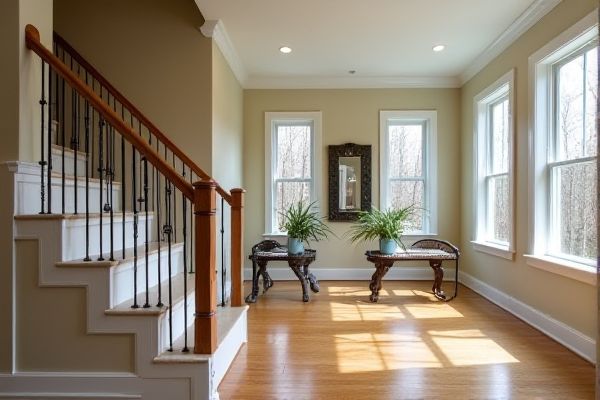
Composite railing offers superior durability, low maintenance, and resistance to weather compared to metal railing, which can be prone to rust and corrosion over time. Discover which railing material best suits Your outdoor space by exploring the detailed comparison in this article.
Table of Comparison
| Feature | Composite Railing | Metal Railing |
|---|---|---|
| Material | Wood fibers + plastic | Steel, aluminum, or iron |
| Durability | Resistant to rot, insects, and weather | Strong, may rust without coating |
| Maintenance | Low maintenance, occasional cleaning | Requires regular painting or rust treatment |
| Appearance | Wood-like finish, variety of colors | Modern or classic look, customizable |
| Cost | Moderate to high | Varies: aluminum (low), wrought iron (high) |
| Installation | Easy, lightweight | Can be heavy, needs skilled labor |
| Environmental Impact | Recyclable, eco-friendly options available | Recyclable but energy-intensive production |
| Safety | Sturdy, smooth surface | Strong, may have sharp edges if damaged |
Introduction to Composite and Metal Railings
Composite railings combine wood fibers and plastic to offer durability, low maintenance, and resistance to rot, making them ideal for long-lasting outdoor use. Metal railings, typically made from aluminum, steel, or wrought iron, provide superior strength, a sleek appearance, and enhanced security but may require periodic maintenance to prevent rust. Your choice between composite and metal railings should consider factors like climate, desired aesthetic, and long-term upkeep.
Material Composition and Construction
Composite railing consists of a blend of wood fibers and plastic resins, offering enhanced durability and resistance to rot, insects, and weathering compared to traditional materials. Metal railing, typically made from aluminum, steel, or wrought iron, provides superior strength and rigidity but may require protective coatings to prevent rust and corrosion. Your choice between composite and metal railing hinges on balancing maintenance preferences with desired aesthetic and structural qualities.
Aesthetic Appeal: Design and Color Options
Composite railing offers a wide range of design styles and color options that mimic natural wood grains, providing a warm and customizable aesthetic appeal for your outdoor space. Metal railing, often made from aluminum or steel, features sleek, modern designs with a variety of finishes such as powder coating, enhancing durability and style with a contemporary edge. Your choice depends on whether you prefer the organic look and rich textures of composite or the clean lines and industrial vibe of metal railings.
Durability and Weather Resistance
Composite railings offer superior durability and weather resistance compared to metal railings, as they are constructed from a blend of wood fibers and plastic that resists rot, rust, and corrosion. Metal railings, such as aluminum or steel, can be prone to rust and require regular maintenance or protective coatings to prevent deterioration in harsh weather conditions. Composite materials maintain their structural integrity and appearance longer in moisture, UV exposure, and temperature fluctuations, making them ideal for outdoor environments.
Maintenance Requirements
Composite railing requires minimal maintenance due to its resistance to rot, insect damage, and fading, eliminating the need for regular painting or staining. Metal railing, while durable, often necessitates periodic rust treatment, repainting, and inspections to prevent corrosion and maintain structural integrity. Choosing composite railing significantly reduces long-term upkeep costs compared to metal railing's ongoing maintenance demands.
Installation Process and Complexity
Composite railing typically offers a simpler and faster installation process due to its lightweight materials and pre-fabricated components, reducing the need for specialized tools or extensive labor. Metal railing installation often requires precise measurements, welding or drilling, and heavy-duty hardware, making it more complex and time-consuming. Both types demand proper alignment and secure fastening to ensure safety and durability, but composite railings generally provide a more user-friendly and accessible option for DIY projects.
Cost Comparison and Budget Considerations
Composite railings typically cost between $40 and $70 per linear foot, offering durability and low maintenance that can reduce long-term expenses. Metal railings, such as aluminum or steel, range from $30 to $100 per linear foot depending on the material and design complexity, generally requiring periodic maintenance to prevent corrosion and rust. Budget considerations should include initial installation costs, maintenance frequency, and lifespan, with composite railings often presenting higher upfront costs but lower ongoing maintenance compared to metal alternatives.
Safety Features and Performance
Composite railings offer enhanced safety features due to their resistance to rot, splintering, and corrosion, reducing the risk of structural failure and injuries over time. Metal railings, typically made from aluminum or steel, provide superior strength and durability, often meeting stringent building codes and offering reliable support against heavy impacts. Both materials deliver excellent performance in terms of stability and longevity, but composite railings excel in low maintenance and weather resistance, while metal railings ensure maximum load-bearing capacity and fire resistance.
Environmental Impact and Sustainability
Composite railing offers a more sustainable option by utilizing recycled materials and significantly reducing the demand for virgin timber, which helps conserve natural forests. Metal railing, often made from aluminum or steel, can be recycled but involves energy-intensive mining and production processes that contribute to higher carbon emissions. Your choice between these options should consider the environmental footprint of manufacturing and the potential for recyclability at the end of the product's life cycle.
Choosing the Right Railing: Key Considerations
Composite railing offers superior resistance to weathering, low maintenance, and a variety of design options, making it ideal for long-lasting aesthetics. Metal railing provides exceptional strength, durability, and sleek modern appeal, but may require regular upkeep to prevent rust and corrosion. Evaluating your project's environmental exposure, maintenance preferences, and budget helps determine whether composite or metal railing best suits your needs.
 homyna.com
homyna.com